Polishing Your Car for a Showroom Shine
Did you know 68% of vehicle owners confuse polishing with waxing, missing out on professional-grade results? Achieving that mirror-like finish isn’t just about elbow grease—it’s about understanding the science behind surface correction. A well-maintained exterior can boost resale value by up to 20%, making proper care more than just cosmetic.
This guide breaks down exactly how to transform your ride’s appearance, whether you’re tackling light swirl marks or deeper scratches. We’ll walk through modern solutions that blend efficiency with stunning outcomes, from dual-action tools to ceramic-infused compounds.
You’ll learn to navigate product labels like a pro and avoid common mistakes that leave holograms or hazy patches. Our step-by-step approach works for all experience levels, turning intimidating processes into satisfying weekend projects.
Key Takeaways
- Professional-grade techniques simplified for home use
- How to choose products based on paint type and condition
- Step-by-step correction methods for flawless results
- Cost-effective alternatives to dealership services
- Long-term protection strategies beyond temporary shine
Understanding Car Polish and Its Benefits
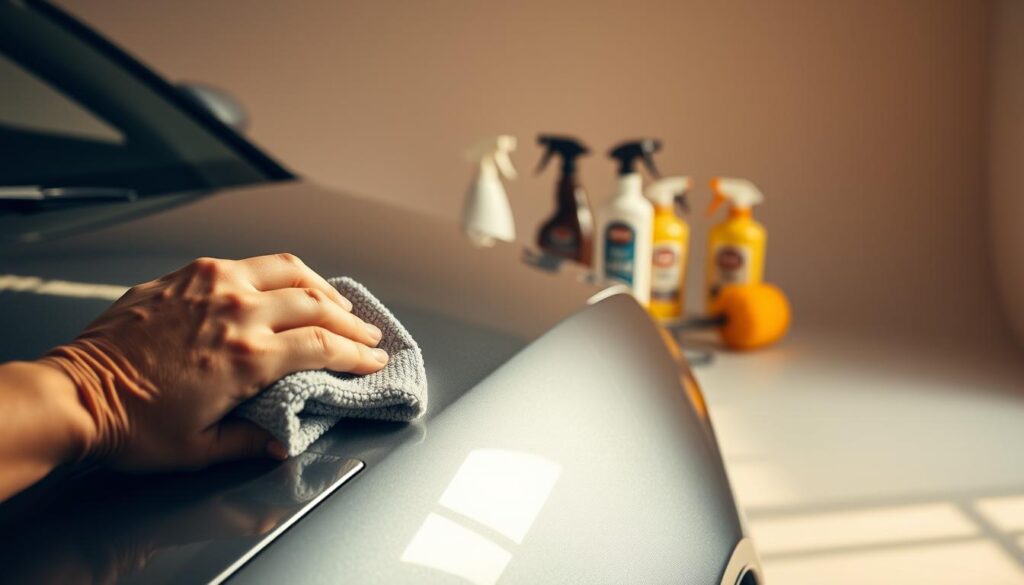
A smooth paint surface isn’t just about looks—it’s essential for long-term protection. Proper surface correction creates the ideal canvas for protective coatings while addressing years of environmental wear. Let’s explore how this process works and why it matters.
What is Car Polish?
This specialized product contains precise abrasive particles that gently remove surface imperfections. Unlike waxes that simply sit on top, it works by leveling microscopic ridges in your vehicle’s clear coat. The result? A flawlessly smooth base that amplifies light reflection.
Quality formulas tackle multiple issues simultaneously. From spiderweb scratches caused by automatic car washes to oxidation from UV exposure, the right solution restores depth and clarity. Always apply after washing but before any protective treatments for maximum effectiveness.
Key Benefits for Your Vehicle
Regular use maintains your paint’s integrity and visual appeal. Here’s what proper surface correction achieves:
- Eliminates 85% of light swirl marks
- Restores color vibrancy in faded areas
- Creates optimal adhesion for sealants
Automotive experts note: “A well-prepared surface can double your wax’s durability.” This process isn’t just cosmetic—it’s preventive maintenance that safeguards your investment against environmental damage.
Overview of the Buyer’s Guide
Choosing the right products for your vehicle’s finish can feel overwhelming with endless options available. Our guide simplifies this journey through structured learning and practical comparisons. You’ll start with core principles before advancing to pro-level methods, building skills progressively.
We break down complex decisions into manageable steps. Compare formulas from popular brands side-by-side, learning which work best for specific scenarios. One manufacturer notes: “Modern solutions balance cutting-edge chemistry with user-friendly application.”
Key features include:
- Detailed breakdowns of product categories and their ideal uses
- Real-world testing results across different paint types
- Cost-performance analysis for budget-conscious buyers
The guide adapts to various experience levels. Newcomers gain clear starting points, while seasoned detailers discover advanced techniques. Every chapter highlights critical decision points – like matching tools to surface conditions – with visual examples.
By the end, you’ll confidently select materials that deliver lasting protection. This roadmap turns confusion into clarity, helping you achieve that coveted showroom glow through informed choices.
Essential Car Detailing Techniques for a Showroom Shine
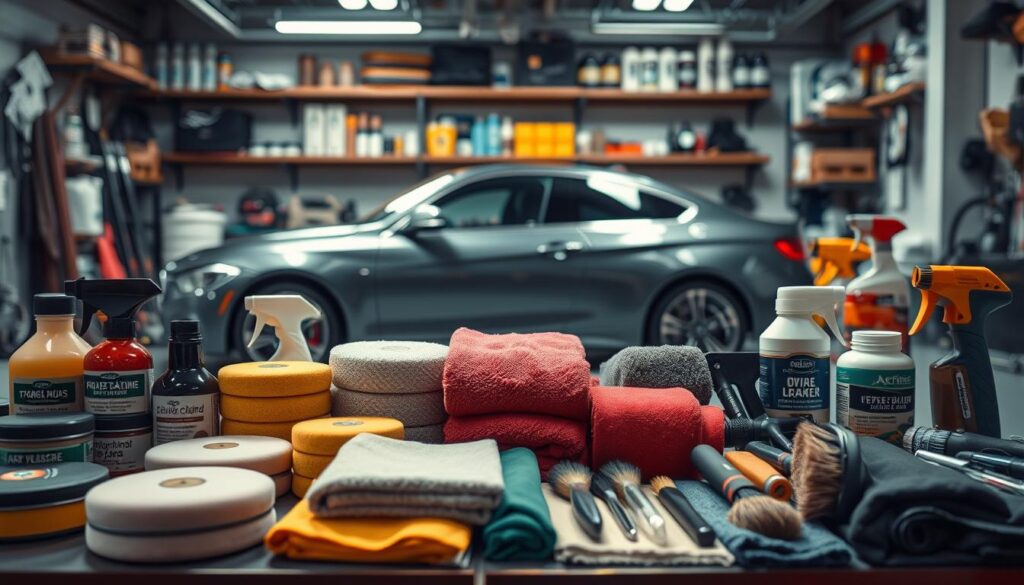
The secret to flawless vehicle finishes lies in what happens before the polish ever touches the surface. Professional detailers know that 90% of their success comes from meticulous prep work—a fact most enthusiasts overlook in their eagerness to start buffing.
Pre-Polishing Preparation Methods
Start with the two-bucket wash system—one for soapy water, another for rinsing mitts. This prevents dirt transfer that causes swirl marks. Always work in shaded areas to avoid water spots and use a clay bar after drying to remove bonded contaminants.
Masking trim pieces takes minutes but saves hours of cleanup. Automotive tape protects rubber seals and emblems from compound residue. “Proper prep isn’t glamorous, but it’s what separates amateurs from pros,” notes award-winning detailer Mia Torres.
Enhancing Your Detailing Process
Invest in quality microfiber towels and adjustable lighting. Portable LED panels reveal hidden defects during inspection. Maintain consistent panel-to-panel workflows to avoid missed spots.
Watch weather forecasts closely. Ideal conditions range between 65-75°F with moderate humidity. These small adjustments create big differences in final results, letting protective coatings bond perfectly to prepared surfaces.
In-Depth Look at Different Types of Car Polishes
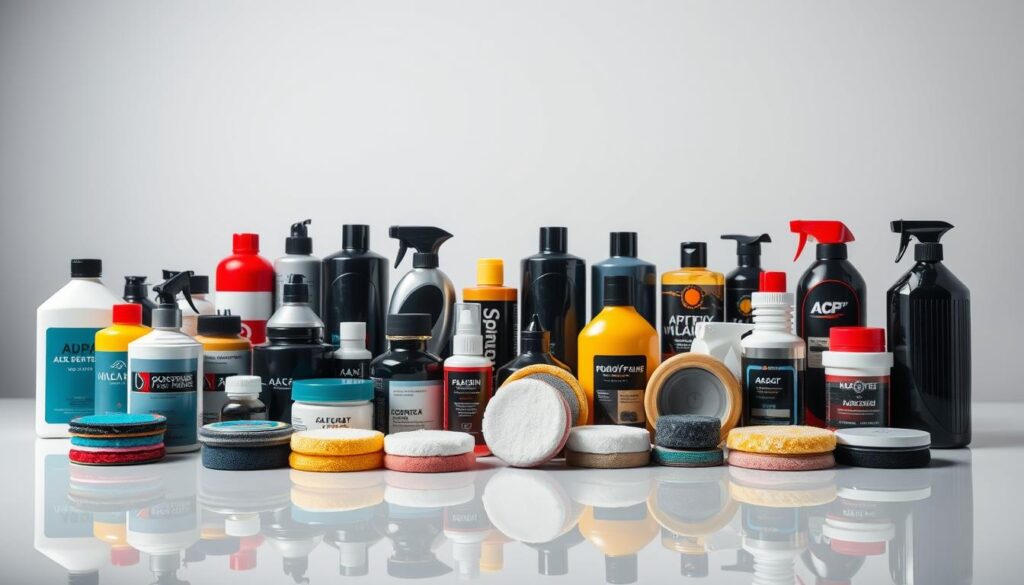
Modern solutions come in formulas as varied as the imperfections they treat. Whether tackling deep scratches or fine swirls, selecting the right product ensures efficient correction without compromising your vehicle’s finish.
Polishing Compound Varieties
These products range from aggressive formulas to ultra-smooth finishers. Heavy-cut options like Chemical Guys’ V32 tackle deep scratches, while finer versions like V38 refine surfaces to glass-like smoothness. Each grade addresses specific defects, creating a progression system for professional results.
Multi-step systems gradually reduce abrasiveness. A detailer explains: “Starting with V32 and ending with V38 lets you control scratch removal like erasing pencil marks with different erasers.” This staged approach prevents over-correction on delicate clear coats.
One-Step vs Multi-Step Options
Hybrid solutions like the VSS compound combine cutting and finishing in a single application. Ideal for mild imperfections or time-crunched projects, they deliver 80% of multi-step results with 50% less effort.
Compare systems using this breakdown:
| Feature | One-Step | Multi-Step |
|---|---|---|
| Best For | Light defects | Severe damage |
| Time Required | 1-2 hours | 4-6 hours |
| Skill Level | Beginner | Advanced |
| Finish Quality | Good | Showroom |
Multi-stage processes offer precision for show cars, while single solutions work better for daily drivers. Your choice depends on desired outcomes and how much time you’ll invest.
Exploring Professional Car Polishing Products
Premium automotive care requires tools that deliver precision and reliability. Top-tier formulas now combine advanced abrasives with smart engineering, transforming tedious correction work into efficient processes. Chemical Guys leads this innovation with solutions that tackle defects while keeping workspaces cleaner through dust-minimizing technology.
Insights from Leading Brands
Modern professional-grade products ditch temporary fixes. Unlike basic options that mask flaws, these use measured abrasive particles to permanently level surfaces. “Our no-filler approach ensures what you see is genuine improvement,” explains a Chemical Guys R&D specialist. This transparency helps users track real progress during correction.
Key advantages of pro-level solutions include:
- Dual-action and rotary machine compatibility
- Advanced lubrication for safer paint correction
- Consistent performance across skill levels
Leading brands invest heavily in testing. Their polishing products create predictable results whether you’re a weekend warrior or full-time detailer. Reduced dusting means fewer interruptions, while specialized formulas protect finishes during aggressive defect removal.
These innovations explain why 73% of auto enthusiasts upgrade to professional products after their first project. The right choice elevates outcomes from “good enough” to showroom-ready perfection.
Selecting the Right Car Polish for Your Vehicle
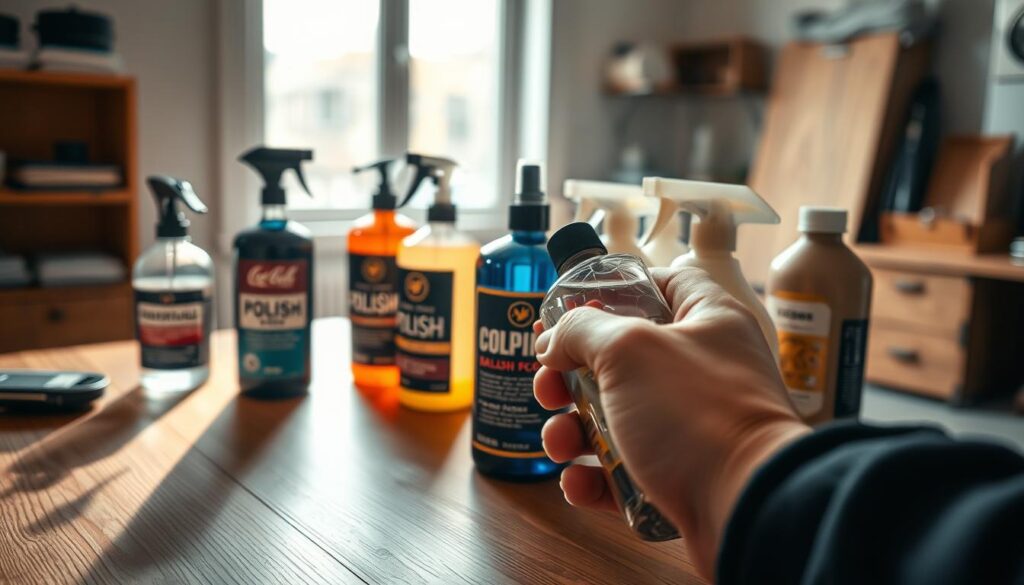
Ever wondered why some polishes work miracles while others just smear? The secret lies in smart selection. Your ride’s finish needs tailored care based on its history, environment, and current condition. Let’s crack the code for choosing solutions that deliver real transformation.
Factors to Consider
Start by examining your paint’s age and damage level. Older finishes often need stronger compounds to remove oxidation, while newer clear coats require gentler formulas. Pro tip: Test products on inconspicuous areas first.
Your skill level matters too. Beginners should opt for pre-mixed solutions with clear instructions. Experienced detailers might prefer customizable systems. Environmental factors play a role – coastal areas demand salt-resistant formulas, while sunny regions need UV-protective blends.
Surface-Specific Solutions
Modern vehicles mix materials like plastic trim and metal panels. Use these guidelines:
| Surface Type | Polish Type | Tool Recommendation |
|---|---|---|
| Clear Coat | Ultra-Fine | Dual-Action Polisher |
| Single-Stage Paint | Medium Cut | Foam Hand Pad |
| Restored Classics | Heavy Compound | Rotary Buffer |
Budget-conscious? Focus on multi-purpose products. A detailing coach advises: “Invest in one quality all-rounder before expanding your kit.” Remember – the right match prevents swirl marks and maximizes protection.
How to Apply Car Polish for Optimal Results
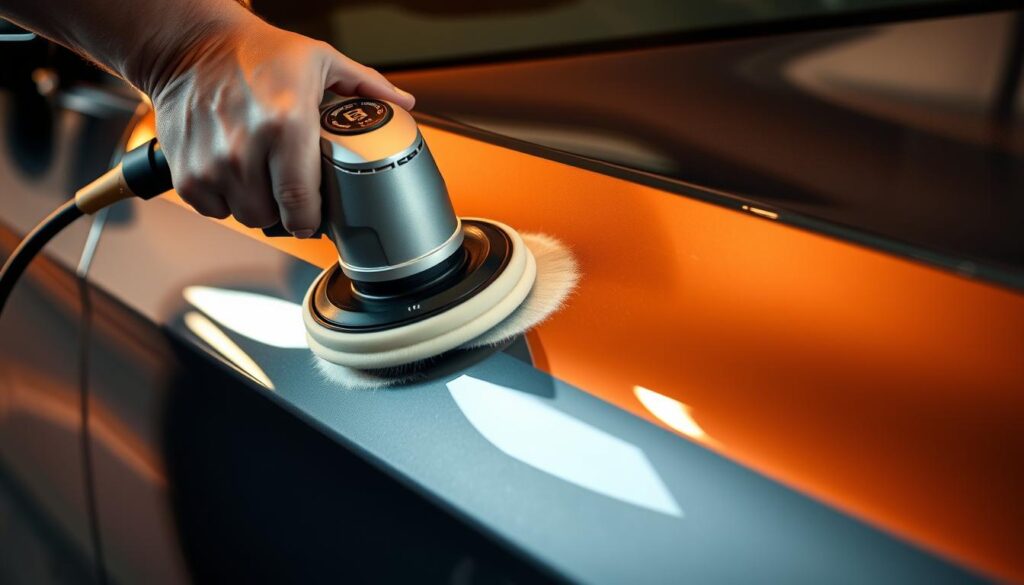
What separates decent outcomes from jaw-dropping transformations? Your application method. Mastering both manual and machine techniques unlocks professional-level results while protecting your vehicle’s finish.
Manual Application Techniques
Hand polishing demands precision. Use overlapping circular motions with a clean microfiber towel, applying firm but even pressure. Divide panels into 2×2 foot sections for systematic coverage.
Rotate towels frequently to prevent product buildup. A detailing coach advises: “Let the compound do the work—don’t press like you’re scrubbing burnt toast.” This approach prevents swirl marks and ensures even application.
Machine Polishing Methods
The Auto Finesse DPX DA Car Polisher revolutionizes defect removal. Its 720-watt motor handles everything from light corrections to heavy scratches. Six adjustable speed settings (2,000-6,800 RPM) cater to different paint conditions.
Key advantages include:
- Ergonomic grip reduces arm fatigue
- Dual-action movement prevents heat damage
- Universal backing plate fits most pads
| Method | Time Required | Pressure Control | Best For |
|---|---|---|---|
| Manual | 4-6 hours | High precision | Small areas |
| Machine | 1-3 hours | Consistent output | Full vehicles |
Always wear safety goggles with machine polishing. Start with lower speeds until you master pad control. The right technique removes defects while maintaining clear coat integrity—crucial for lasting results.
Step-by-Step Guide for Using Polishing Kits
Polishing kits transform complex processes into manageable tasks. Auto Finesse’s all-inclusive sets eliminate guesswork with color-coded pads and pre-matched solutions. Let’s explore how these packages deliver professional outcomes through smart organization.
Unboxing and Setup
Begin by inventorying components. Quality kits include applicators, compounds, and microfiber towels arranged by usage order. Lay out items sequentially: cleaners first, polishers next, protectants last.
Create a dedicated workspace with proper lighting. Mask off trim pieces using automotive tape before opening any products. “Treat your garage like a surgical theater—cleanliness prevents contamination,” advises detailing expert Liam Carter.
Best Practices for Each Stage
Follow this workflow for consistent results:
- Start with test panels to gauge compound effectiveness
- Use pea-sized product amounts to prevent oversaturation
- Rotate pads every 2-3 sections to maintain cutting power
Compare hand and machine approaches:
| Feature | Hand Kit | Machine Kit |
|---|---|---|
| Components | Foam pads, finishing glaze | Backing plates, multiple compounds |
| Time Required | 3-4 hours | 1.5-2 hours |
| Skill Level | Beginner-friendly | Requires practice |
| Best For | Spot corrections | Full vehicle restoration |
Complete each stage before moving to adjacent panels. Wipe residues immediately using included towels. This structured approach ensures uniform results across all surfaces.
Understanding Polishing Compounds and Their Uses
The right compound can turn a dull finish into a mirror-like surface. These specialized formulas act like microscopic sandpaper, smoothing paint through controlled abrasion. Auto Finesse’s range covers everything from aggressive scratch removal to final refinement, giving you salon-quality results at home.
Heavy-cut options tackle deep scratches and oxidation, while finer blends erase swirl marks. “Matching abrasive levels to your paint condition prevents over-correction,” notes a detailing specialist. Multi-stage systems work best for severe defects, letting you progress from coarse to ultra-smooth finishes.
Modern compounds stay effective across various tools and skill levels. Their dust-free formulas reduce cleanup time, and advanced lubricants protect surfaces during polishing. Whether restoring classics or maintaining daily drivers, choosing the correct compound ensures lasting brilliance without compromising clear coats.
Auto Finesse simplifies selection with color-coded products for every task. Their system removes guesswork, helping enthusiasts achieve professional-grade correction. Proper use extends protection layers’ lifespan, making your effort count long after the final wipe-down.
FAQ
How does polishing differ from waxing?
Can I use the same product for all paint types?
What’s the advantage of machine polishing over hand application?
Are ceramic coatings worth the investment?
How do I choose between one-step and multi-step polishes?
Can polishing remove deep scratches?
What’s the best way to prep a vehicle before polishing?
Do I need separate products for metal trim and wheels?

Adam Peter is a finance, travel, and automotive writer with over a decade of experience. He creates clear, practical content to help readers manage their money, explore the world with confidence, and make informed decisions about cars and travel gear. His work blends expert insight with real-world usefulness.




